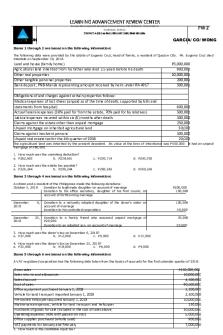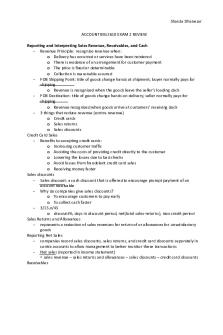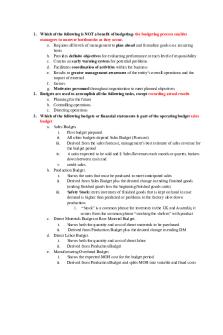Review #22 - Accounting 002 PDF

| Title | Review #22 - Accounting 002 |
|---|---|
| Course | Accounting |
| Institution | California State University Northridge |
| Pages | 5 |
| File Size | 66.1 KB |
| File Type | |
| Total Downloads | 51 |
| Total Views | 174 |
Summary
Accounting 002...
Description
Accounting 002 Date: 08/20/2021 Chapter 22 Review 1. In responsibility accounting, unit managers are evaluated only on
things that they can a. Control 2. A department that incurs costs without generating revenues is considered a(n): a. Cost Center 3. Each of the following are a type of center in responsibility accounting: a. cost b. profit c. investment 4. A department that is evaluated on their success in generating income is a(n): a. Profit Center 5. A department that incurs costs, generates revenues, and is responsible for effectively using department assets is considered a(n): a. Investment Center 6. In responsibility accounting, unit managers are evaluated on: a. costs they have control over 7. A cost that a manager has the power to determine or at least significantly affect is called a(n) ______ cost. a. Controllable Cost 8. The accounting department of a manufacturing company is a(n): a. Cost Center 9. A(n) _____ cost is not within the manager's control or influence. a. Uncontrollable Cost 10.Center's method of evaluation
2 a. Cost Center : Ability to control actual costs compared to budgeted costs b. Profit Center : Ability to generate revenues c. Investment Center : Ability to generate income 11.The purpose of a responsibility accounting system is to provide information to: a. assign costs and expenses to the managers responsible for controlling them. b. evaluate managers' performance. 12.A _____ center manager is evaluated on their success in generating income. a. Profit Center 13.The manager of a certain division at Alpha Manufacturing is evaluated on how efficiently the division uses equipment, buildings, and other assets to generate profits. This division is considered a(n): a. Investment Center 14.The best data to use to measure a department manager's performance is found on a: a. responsibility accounting performance report 15.Upper-level management uses responsibility accounting ______ to evaluate the effectiveness of lower-level managers in controlling costs and expenses and keeping within budgeted amounts. a. Performance reports 16.When comparing responsibility accounting performance reports for upper-level management to those of lower-level management, responsibility and control ________ for upper-level management; therefore, their reports contain ________ detail. a. broaden; less 17.Responsibility accounting provides relevant information to the manager who does all of the following except: a. pays for the cost 18.Profit centers commonly use the following statement to report profit center performance:
3 a. departmental income statement 19.A responsibility accounting performance report contains which of the following items? a. Actual amounts b. A list of all controllable costs c. The difference between actual and budgeted amounts d. Budgeted amounts 20.A good responsibility accounting system makes every effort to provide: a. cost information to the person who controls the cost. b. detailed cost information to all levels of management. 21.Challenges that involve allocating expenses include: a. how to allocate indirect expenses b. how to allocate service department costs 22.Costs that are incurred for the joint benefit of more than one department and cannot be readily traced to only one department are called ______ expenses. a. Indirect Expenses 23.True or false: Controllable costs are the same as direct costs. a. False 24.In the general model for cost allocation, total allocated cost equals a. total cost to allocate times percentage of allocation base used 25.Costs readily traced to a department because they are incurred for that department's sole benefit are called ______ expenses. a. Direct Expenses 26.True or false: Standard rules exist to help managers identify appropriate allocation bases. a. False 27.The general model for cost allocation is Allocated cost = a. Total cost to allocate x Percentage of allocation base used. 28.Match each indirect expense to the most likely allocation base. a. Wages and salaries : Number of hours worked b. Rent : Square feet of floor space occupied c. Advertising : Total Sales d. Equipment depreciation : Machine hours used
4 e. Insurance : Value of assets 29.Departmental income statements include: a. direct and indirect expenses 30.A ______ center is evaluated based on control of costs so a performance report is prepared instead of an income statement. a. Cost Center 31.Personnel expenses would most likely be allocated to operating departments using which allocation base? a. Number of employees 32.List the sections of a departmental expense allocation spreadsheet with the first section on top. a. Direct Expenses b. Indirect Expenses c. Service Department Expenses d. Total Expenses 33.List the steps in allocating costs to operating departments and preparing departmental income statements, with the first step on top. a. Accumulate direct expenses by department b. Allocate indirect expenses across department c. Allocate service department expenses to operating departments d. Prepare departmental income statements 34.Operating department income statements are used to evaluate the performance of ______ centers. a. Profit Centers 35.Behavioral aspects of departmental performance reports include a. including uncontrollable costs in performance evaluation can reduce manager morale b. allocating budgeted service department costs helps to control their costs c. including indirect expenses in the department manager's performance evaluation can help reduce the organization's costs 36.A departmental expense allocation spreadsheet is used to allocate expenses: a. from service departments to operating departments
5 37.A departmental contribution to overhead report shows indirect expenses: a. in total, but not allocated to departments 38.Potential effects of departmental performance reports on employee behavior include all of the following except: a. Including uncontrollable costs can serve to improve a manager's morale. 39.Evaluating a manager's performance on financial measures only has limitations. Therefore, companies should consider ______ measures to help evaluate manager performance. a. Nonfinancial measures 40.The balanced scorecard is a unique system of performance measures in that it: a. has financial and nonfinancial measures. b. has multiple perspectives. c. has a focus on customer satisfaction 41.Which of the indicators listed would be considered performance measures from the customer perspective? a. Percent of on-time deliveries b. Time to fill orders c. Percent of sales returned 42.Transfer pricing can use the following approaches: a. cost b. market price c. negotiated price...
Similar Free PDFs

Review #22 - Accounting 002
- 5 Pages

Review #21 - Accounting 002
- 6 Pages

Chapter 22 Review Questions
- 32 Pages

Accounting review
- 13 Pages

21 n 22 LS Review
- 11 Pages

Quiz 5.2 Review 9/22
- 3 Pages

Review for Financial Accounting
- 35 Pages

Accounting Exam 2 Review
- 10 Pages

Accounting 1 Review
- 4 Pages

Accounting Final Review
- 9 Pages

Accounting Exam 1 Review
- 3 Pages

Accounting 101 for review
- 21 Pages

Accounting Exam 2 Review
- 17 Pages

Accounting Exam 2 Review
- 8 Pages

Sithind 002
- 28 Pages

Accounting 2 chapters 21 and 22
- 6 Pages
Popular Institutions
- Tinajero National High School - Annex
- Politeknik Caltex Riau
- Yokohama City University
- SGT University
- University of Al-Qadisiyah
- Divine Word College of Vigan
- Techniek College Rotterdam
- Universidade de Santiago
- Universiti Teknologi MARA Cawangan Johor Kampus Pasir Gudang
- Poltekkes Kemenkes Yogyakarta
- Baguio City National High School
- Colegio san marcos
- preparatoria uno
- Centro de Bachillerato Tecnológico Industrial y de Servicios No. 107
- Dalian Maritime University
- Quang Trung Secondary School
- Colegio Tecnológico en Informática
- Corporación Regional de Educación Superior
- Grupo CEDVA
- Dar Al Uloom University
- Centro de Estudios Preuniversitarios de la Universidad Nacional de Ingeniería
- 上智大学
- Aakash International School, Nuna Majara
- San Felipe Neri Catholic School
- Kang Chiao International School - New Taipei City
- Misamis Occidental National High School
- Institución Educativa Escuela Normal Juan Ladrilleros
- Kolehiyo ng Pantukan
- Batanes State College
- Instituto Continental
- Sekolah Menengah Kejuruan Kesehatan Kaltara (Tarakan)
- Colegio de La Inmaculada Concepcion - Cebu